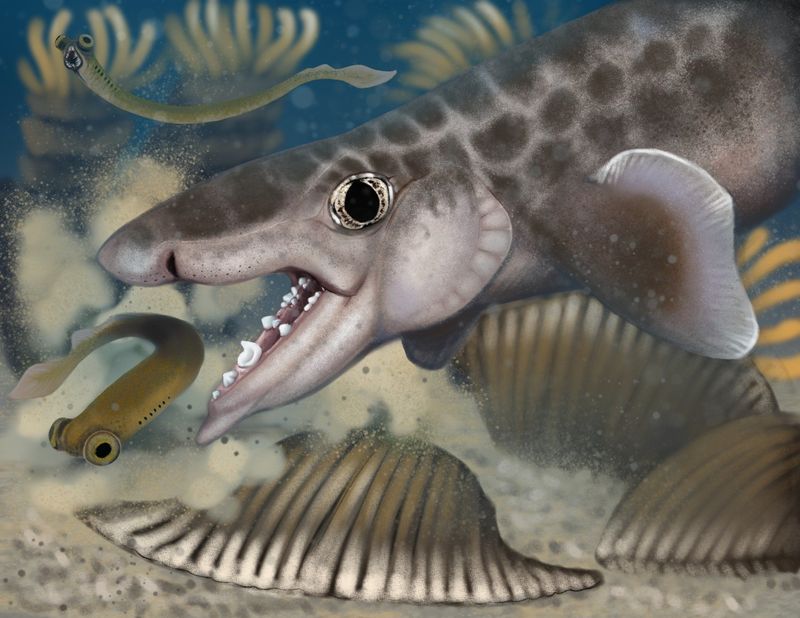Unknown Shark Species Discovered Deep Within the World’s Longest Cave
In a remarkable paleontological breakthrough, scientists have identified a previously unknown species of extinct shark hidden deep within Mammoth Cave in Kentucky, the world’s longest known cave system.
The species, named Macadens olsoni, was small by shark standards, measuring less than a foot in length. What truly set it apart was its highly unusual set of teeth.
Unlike most sharks, which have multiple rows of teeth, this ancient species had a single row along each side of its jaw, with three prominent teeth positioned at the front. According to researchers, this arrangement has never been seen in any other known shark species. Its specialized teeth suggest a diet that included mollusks and worms.
The fossil was discovered within the Ste. Genevieve Formation, a layer of rock that dates back roughly 335 to 340 million years, placing Macadens olsoni in a time long before the age of dinosaurs.
The find was the result of a collaborative effort between the National Park Service’s Paleontology Program, Mammoth Cave National Park, and the Smithsonian Institution’s Paleobiology Department. The species’ name honors both Mammoth Cave itself and Rickard Olson, a retired park scientist whose extensive work was critical in cataloging shark fossils during a recent Paleontological Resource Inventory.
The real standout detail lies in its teeth.

"This discovery is a remarkable addition to our understanding of ancient marine life and underscores the importance of preserving and studying our natural history," Superintendent Barclay Trimble said.
"This finding not only enhances our knowledge of ancient marine ecosystems but also emphasizes the critical role of paleontological research in our national parks," he added. "Every discovery connects the past with the present and offers invaluable educational opportunities for students and the public."
Understanding the Psychology of Discovery
The discovery of a new species, such as Macadens olsoni, can elicit a strong sense of excitement and curiosity. This reaction can be explained by the psychological concept of novelty-seeking behavior. According to a study published in Neuropsychopharmacology, novelty seeking is a trait that prompts exploratory behavior in response to novel, complex, or unexpected stimuli. It's a fundamental aspect of human nature that drives our pursuit of knowledge and innovation.
In a remarkable paleontological breakthrough, scientists have identified a previously unknown species of extinct shark hidden deep within Mammoth Cave in Kentucky, the world’s longest known cave system.
In addition to Macadens olsoni, the research team revisited another fossil specimen previously classified as Helodus coxanus. After careful analysis, the species was renamed Rotuladens, which means “wheel tooth” in Latin, a reference to the distinct shape of its teeth. Both species reveal unique adaptations, giving scientists a clearer picture of the diversity of prehistoric marine life that once inhabited the waters covering what is now Kentucky.
Mammoth Cave, already a geological wonder, is proving to be just as extraordinary for what it hides beneath its limestone passages. These discoveries add to a growing body of evidence that the cave’s ancient formations preserve a rich archive of life from Earth’s deep past.
Furthermore, our fascination with sharks, in particular, may stem from a psychological phenomenon known as 'fearful fascination.' According to Dr. Susan David, an expert in emotional agility, "We are often drawn to what scares us because it allows us to explore our limits and experience a thrill, especially when we can observe it from a safe distance." This concept highlights the complex relationship between fear and attraction, particularly in the context of creatures like sharks.
What Research Shows About Fear and Fascination
Research has shown that fear can indeed be a powerful motivator for learning. In a study published in PLOS One, participants who experienced fear showed a significant increase in their knowledge and understanding of the topic that induced the fear. This might explain why discovering a new species of shark, a creature often associated with fear, can spark such intense interest and curiosity.
Analysis & Alternative Approaches
In conclusion, our psychological response to the discovery of Macadens olsoni is a fascinating blend of novelty-seeking behavior and fearful fascination. Not only does it highlight our inherent curiosity and desire for knowledge, but it also underscores the complex ways in which fear can stimulate learning and exploration. As Dr. Dan Ariely, a behavioral economist, notes, "Understanding our fears can lead to greater insights and discoveries." As we continue to delve into the unknown, it's these psychological principles that will continue to drive our quest for discovery. (Neuropsychopharmacology, Dr. Dan Ariely, PLOS One)



